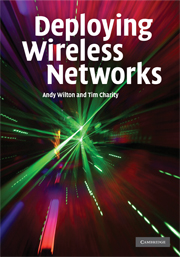Book contents
- Frontmatter
- Contents
- Foreword by Sir David Brown, FREng
- Preface
- Acknowledgements
- Authors' disclaimer
- 1 Introduction
- 2 Wireless network systems
- 3 Principles of access network planning
- 4 Introduction to RAN planning and design
- 5 GSM RAN planning and design
- 6 UMTS RAN planning and design
- 7 Cellular OFDM RAN planning and design
- 8 Mesh network planning and design
- 9 Core network and transmission
- 10 Network operation and optimisation
- Acronyms
- Index
- References
10 - Network operation and optimisation
Published online by Cambridge University Press: 13 August 2009
- Frontmatter
- Contents
- Foreword by Sir David Brown, FREng
- Preface
- Acknowledgements
- Authors' disclaimer
- 1 Introduction
- 2 Wireless network systems
- 3 Principles of access network planning
- 4 Introduction to RAN planning and design
- 5 GSM RAN planning and design
- 6 UMTS RAN planning and design
- 7 Cellular OFDM RAN planning and design
- 8 Mesh network planning and design
- 9 Core network and transmission
- 10 Network operation and optimisation
- Acronyms
- Index
- References
Summary
The life-cycle of any wireless telecommunications network broadly follows the process illustrated in Figure 10.1. As discussed in Chapter 3, the initial planning makes technology choices to meet the overall business goals. This leads to the design phase, where detailed studies are made of system capacity and coverage to ensure that the network performance criteria are likely to be met. Once the design is complete, the network infrastructure is ordered, installed and commissioned – depending on the scale of the network, this phase can take many months or even years. Once the network has been built and commissioned, subscribers are given access to the network, which is then said to be operational. The performance of the network is subsequently routinely monitored to ensure that any equipment failures, software problems or other issues are quickly identified. Any problems that do occur are fixed by operational support engineers or automatically dealt with by equipment redundancy and fault correction procedures. Finally, the performance of the stable network is examined, and its configuration is fine-tuned to maximise capacity or optimise the quality of service delivered to the subscribers. If necessary, the cycle is repeated, as new network expansion is planned and the network grows to cope with growth in the subscriber base.
In practice, the phases of the network life-cycle are rarely as distinct as this, and there is much overlap and iteration around the cycle.
- Type
- Chapter
- Information
- Deploying Wireless Networks , pp. 300 - 329Publisher: Cambridge University PressPrint publication year: 2008



